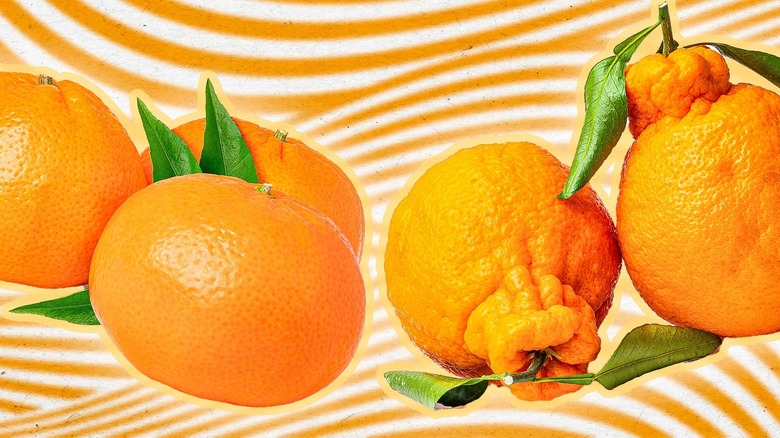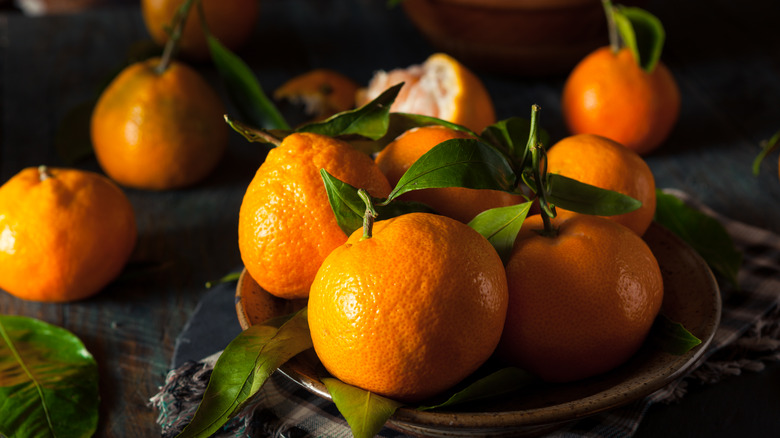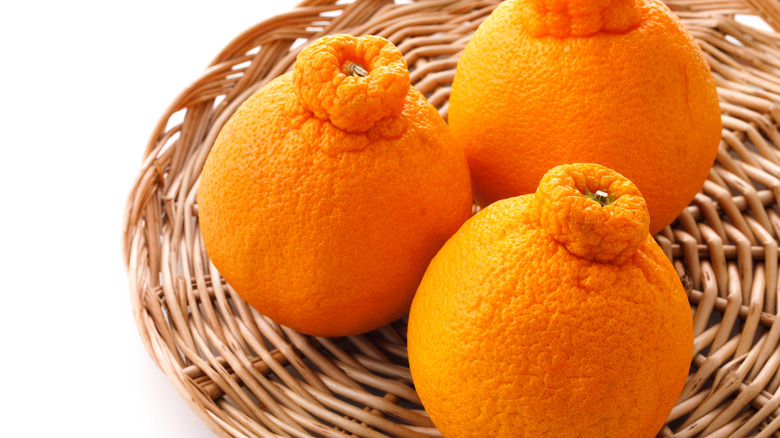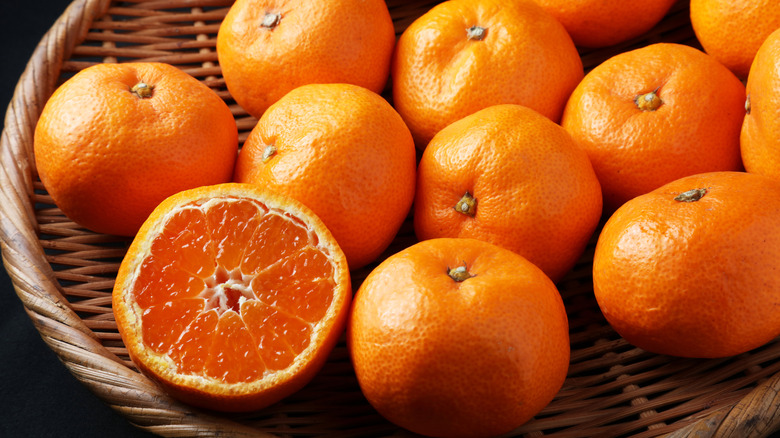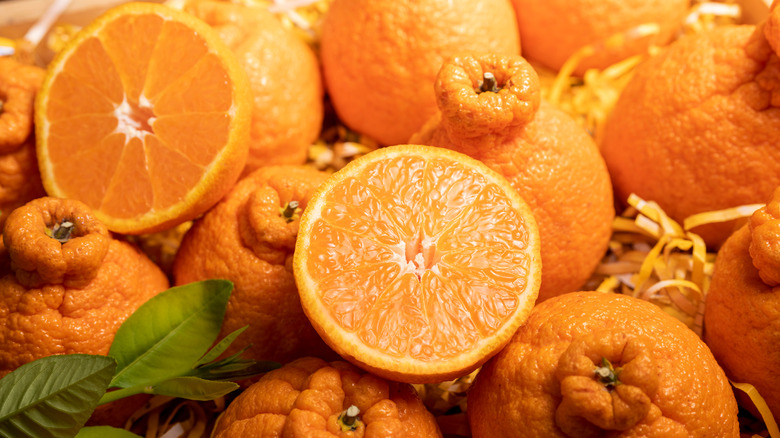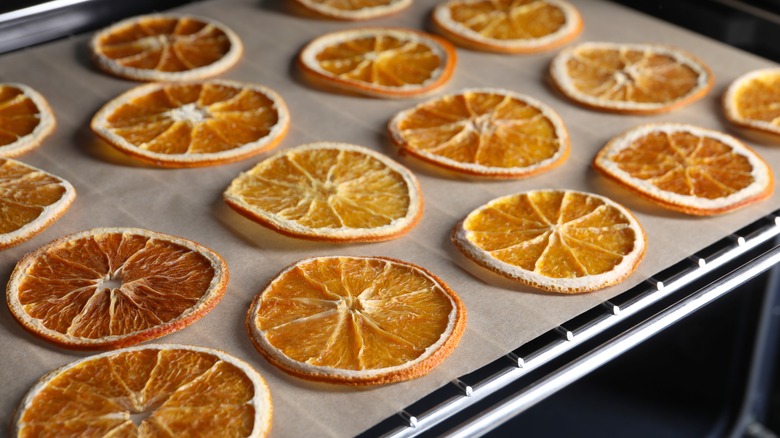Do Satsuma And Shiranui Mandarins Taste Different?
While browsing through the selection of mandarins in your local market's fruit section, you might not think much about scrutinizing how one orange globe would be different from the next, especially in terms of flavor. Mandarin connoisseurs will tell you that no two types of this fruit are alike.
Take satsuma and Shiranui mandarins. The satsuma mandarin presents the ideal visual you might have of the fruit, with its smooth and bright, red-orange peel and slightly oblate shape. The Shiranui mandarin, in comparison, may catch your eye because of its "imperfect" appearance, its peel more wrinkly and less glossy and a protruding lump surrounding its stem.
Beyond the obvious differences in their appearance, both variants have a sweet flavor but with perceptible differences. Hailed by some as the sweetest among citrus fruits, satsuma mandarins have a mild and refreshing acidity whereas the intense flavor of Shiranui mandarins has evoked comparisons to candy. While choosing the taste of one over the other is a matter of personal taste, learning the distinctions between these two types of mandarin opens up possibilities on the different ways you can enjoy them beyond eating them raw.
What are satsuma mandarins?
A hybrid between mandarin and pomelo, satsuma mandarins (Citrus unshiu Marcovitch) are said to have originated in China, although the fact that they're named after what was formerly the Satsuma province (now known as Kyushu) in Japan contests this. In the U.S., these fruits have been grown in Florida, California, Texas, and other states along the Gulf Coast ever since around a million satsuma trees were imported to the country during the early 1900s. Harvest season for satsuma mandarins starts in early fall and lasts throughout winter, and fruits that are left longer on the tree become much sweeter.
Although you can find this fruit sold fresh in the market, it usually reaches consumers in juiced or canned form. That's because its peel bruises easily and requires careful handling, which makes transporting crops difficult. Satsuma mandarins also have a softer texture and more tender flesh compared to other variants like clementines and tangerines. There's a great chance that the canned mandarin oranges you buy are made with this variant.
What are Shiranui mandarins?
Just like satsuma mandarins, Shiranui mandarins (Citrus reticulata Blanco) are delicate and don't fare well when shipped, making their appearance in the market rare. The ones you might find in the grocery are usually labeled "Sumo Citrus," which is a trademark brand for California-grown Shiranui mandarins; the name refers to sumo wrestlers who sport top knots that resemble the fruit's signature bump.
Originally from Japan, this mandarin variant is known in its native country as Dekopon while it is called Hallabong in Korea and Kinsei in Brazil. The variety was developed in 1972 by the Japanese Ministry of Agriculture, Forestry, and Fisheries. Today, the majority of the produce cultivated in the U.S. comes from California, although there are also Shiranui mandarin farms in Florida and Georgia.
A cross between a Ponkan tangerine and a Kiyomi tangor, which is a hybrid of tangerine and orange, Shiranui mandarins can withstand a temperature of 25 degrees Fahrenheit but not any frost below 32 degrees Fahrenheit. They also tend to be larger than other mandarin types, although they rarely get bigger than the average orange. Their harvest season runs from January to April.
Satsuma mandarins offer a balance of sweetness and tartness
Since they're frequently used to make canned mandarin oranges, more people are familiar with how satsuma mandarins taste: Their balance of sweetness and acidity comes with pleasingly tart undertones, resulting in a refreshing flavor. This makes this fruit great in salads, with the zing they'll impart to the dish. They also work well in desserts and sauces. A creative way to use canned satsuma mandarins is to blend the juice with the flesh to make a glaze for roasted chicken. Since this fruit is fragrant, the peel can be zested to give dishes that appetizing citrusy aroma. It can also be candied by simmering them in strips in sugar syrup.
Naturally, they're also great to eat raw. Satsuma mandarins are easy to peel and while they're generally seedless, you might stumble upon some with a few seeds inside. They also have thicker pith — the stringy white stuff between the peel and the flesh — so eating a vesicle feels like there's more to bite into to get to the juice. The flesh itself is tender and succulent, however.
A 120g satsuma mandarin contains 9g of sugar and 2g of fiber. It's also a great source of vitamin C, with a single fruit serving as much as 32mg or around 36% of the recommended daily intake.
Shiranui mandarins' intense flavor comes from being kept in cold storage
When you open a Shiranui mandarin, you'll find that none of its segments contain seeds. Since the peel is easy to remove, eating one on the go is no problem. The bump can serve as a "handle" while you remove the skin and then you can pop its large and juicy vesicles straight into your mouth. It also doesn't have as much pith as a satsuma mandarin.
Should you taste a freshly harvested or backyard-grown Shiranui mandarin, you might be surprised that instead of the intense sweetness you've come to expect, its juice comes with a refreshing acidity that gives its flavor some depth. It would still be sweet but more like honey rather than candy, with notes of orange blossom. The difference is due to how the ones sold in stores have been kept in cold storage for up to 40 days to reduce their acidic content, leaving only an intense, sugary flavor. Shiranui mandarins that have been stored for weeks also develop some browning in the peel and a more pronounced wrinkling.
The tangy flavor of satsuma mandarins can be intensified through preserving methods
We've already mentioned how adding pieces of satsuma mandarin to salads can brighten their flavor and its juice can impart a delicious tang to desserts. You can also make preserves out of this fruit. Satsuma mandarin marmalade would be a versatile ingredient to have around since you can use it as a spread, as a glaze for salmon and other seafood, and as a filling for pastries.
Another way to enjoy this fruit is to slice it thinly and put the pieces in a dehydrator or oven. To have the dried mandarin pieces remain slightly soft and chewy, keep them in the dehydrator for around 12 hours or bake them for 3 hours at 250 degrees Fahrenheit. Otherwise, let them dry out longer so you get crispy discs. The intensified flavor in your dried satsuma mandarin slices will taste great when you dip them in chocolate or caramel sauce.
The distinct sweetness of Shiranui mandarins is great for drinks and sweets
The intense sweetness of Shiranui mandarins lends them well to making compotes, vinaigrettes, and fruity cocktails. They're great for baking, too, with their pronounced flavor giving baked treats a distinct citrusy taste and aroma. Squeezing a Shiranui mandarin over a salad of bitter greens creates a more balanced dish, thanks to its sugary juice.
While not the fruit's natural flavor when it is at its ripest, the candy-like taste of Shiranui mandarins is so rich and distinctive that it's used for orange-flavored sweets. It can also pack your homemade orange liqueur with flavor, especially when you let the liqueur sit for a few weeks. A 235g fruit produced by the Sumo Citrus brand has 29g of sugar, more than twice the content of an average satsuma mandarin. It also offers 163% of the recommended daily intake of vitamin C.
